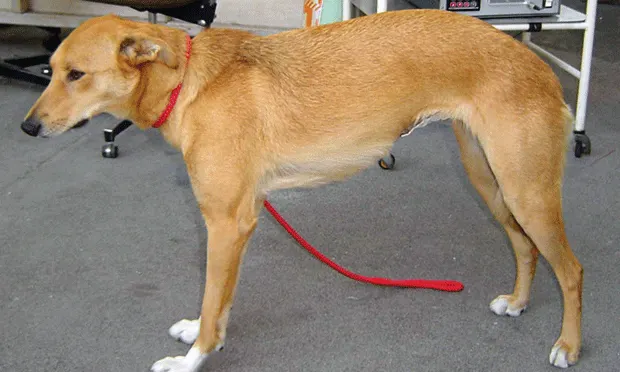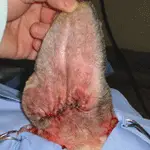Prevent Chronic Pain By Treating Acute Pain First

An acute episode of pain may be self-limiting and resolve without treatment, but it can also lead to a chronic state of pain if untreated.
Above. Some signs, such as a hunched posture following abdominal surgery, are indicative of pain.
PROFILEDefinition
In recent years, the importance of chronic pain has been highlighted in veterinary medicine.
Treatment of diseases such as osteoarthritis is now a major part of general practice.
No data are available regarding the incidence of chronic pain following an acute experience in veterinary patients.
It is reasonable to assume that animals experience chronic pain that is comparable to the pain experienced by humans who have similar medical conditions and undergo similar surgical procedures.
Systems
Disruption of any body system may cause acute pain if nociceptors are stimulated or nerves are damaged.
Incidence/Prevalence
The incidence of chronic pain in the veterinary population is unknown.1
Signalment
Dogs and cats present with numerous conditions that may lead to acute pain.
Some conditions may have a breed predilection (eg, disk protrusion in a dachshund).
Young animals may undergo potentially painful “standard husbandry” procedures, including spaying/neutering, declawing, and tail or ear docking (Table 1).
Table 1. Possible Causes of Acute Pain & Chronic Signs
Risk Factors
The risks for pain associated with surgery may be divided into pre-, intra-, and postoperative factors (Table 2).
These factors may also be implicated in chronic pain of nonsurgical origin.
Table 2. Predictive Factors for Chronic Pain Extrapolated from Humans2
Pathophysiology
The initial nociceptive stimulus (eg, surgical trauma) is converted to an electrical signal (transduced) at the receptor.
This signal is transmitted from the peripheral nerve via the spinal cord to the brain, where it is perceived as pain.
The stimulus also produces a secondary inflammatory response called peripheral sensitization.
A sensitizing combination of inflammatory mediators (eg, prostaglandin, bradykinin) decreases the nociceptive threshold at the site of the injury.
Windup occurs if nociceptive input does not stop and repeated signals to the dorsal horn of the spinal cord summate, causing the spinal neurons to become more excitable.
This in turn leads to central sensitization, in which the entire nervous system becomes more sensitive.
The processes of peripheral and central sensitization can lead to increased sensitivity to stimuli at the site of the injury (primary hyperalgesia) and distant to the site of injury (secondary hyperalgesia).

Total ear canal ablation in a German shepherd
Clinical Signs
Animals in pain typically exhibit abnormal posture, abnormal gait, abnormal general movement, vocalization, and licking or chewing a particular area.3-5
An animal in poor general health may have restlessness or agitation, poor response to caregiver, and lack of grooming.3-5
Increased anxiety commonly manifests as restlessness, hiding, slowness to rise, attempts to bite caregiver, barking, growling, or hissing.3-5
TREATMENT
Where possible, pain management protocols should be initiated early to prevent the risk for long-term CNS changes that can lead to chronic pain (Table 3).
When pain becomes chronic, treatment may be challenging.
Table 3. What, When, & Why of Analgesia
Client Education
Clients and veterinary professionals should not accept pain as inevitable following surgery or certain medical treatments.
Benefits of proper analgesia should be explained to clients.
Alternative Therapy
Alternative neuromodulation therapies may be helpful in cases of chronic pain either alone or as an adjunct to drug treatment.6,7
These include acupuncture, electroacupuncture, percutaneous acupoint electrical stimulation, transcutaneous electrical nerve stimulation, percutaneous electrical nerve stimulation, laser therapy, and pulsed magnetic field therapy.
Physical therapies (eg, physiotherapy, chiropractic, osteopathy) can be used for acute and chronic pain.
IN GENERAL
The nervous system has a large degree of plasticity.
Good surgical technique minimizes tissue damage.
Prolonged nociceptive input can lead to permanent alterations in the CNS, including death of inhibitory neurons, replacement with new afferent neurons, and establishment of aberrant excitatory synaptic connections.
These alterations may lead to intractable pain that is unresponsive to analgesics.
Relative Cost
Relative cost of main analgesic agents: $
Prognosis
Untreated pain may have serious consequences for the animal’s quality of life.
Prevention
Pain routinely assessed as the fifth vital sign.
Planned analgesia that is also responsive to patients requiring other than a “standard” protocol.
Good nursing care (ie, dry and comfortable bed, bladder and bowels emptied, food, water, comfortable dressings, attention from humans).
Regular assessments of in-patients.
Future Considerations
In veterinary medicine, understanding of pain mechanisms and pain prevention is growing.
Newer classes of drugs targeting chronic pain are being introduced in human medicine.
More analgesics are being licensed for veterinary species.
LOUISA SLINGSBY, BVSc, PhD, MRCVS, is a research fellow in veterinary anesthesia at Bristol Veterinary School, University of Bristol, UK. Her areas of interest include clinical analgesia studies in dogs and cats, multimodal analgesia, preemptive analgesia, pharmacokinetic and pharmacodynamic studies of analgesics, and the pharmacogenetics of opioid analgesic use in cats.
Related Articles:Assessing PainPain Management in Cats
PREVENT CHRONIC PAIN: TREAT ACUTE PAIN FIRST • Louisa SlingsbyReferences
1. Long-term pain in cats: How much do we know about this important welfare issue? Robertson SA, Lascelles BD. J Feline Med Surg 12:188-199, 2010.2. Chronic pain as an outcome of surgery: A review of predictive factors. Perkins FM, Kehlet H. Anesthesiology 93:1123-1133, 2000.3. Pain management in cats––Past, present and future. Part 1. The cat is unique. Taylor PM, Robertson SA. J Feline Med Surg 6:313, 2004.4. AAHA/AAFP pain management guidelines for dogs and cats. Hellyer P, Rodan I, Brunt J, et al. J Feline Med Surg 9:466-480, 2007.5. Assessment and management of acute pain in cats. Robertson SA. JVECC 15:261-272, 2005.6. Acupuncture for management of pain. Gaynor JS. Vet Clin North Am Small Anim Pract 30:875-884, 2000.7. Handbook of Veterinary Pain Management. Gaynor JS, Muir WW—St. Louis: Mosby, 2002.